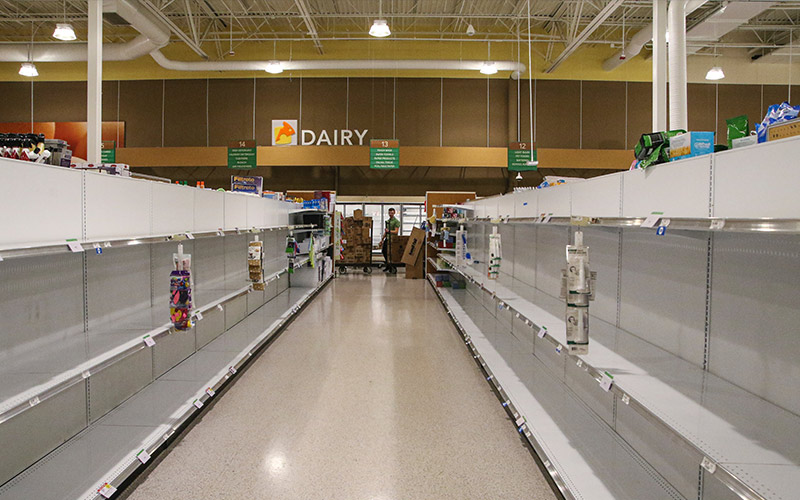COVID-19 Survey: Consumer Trends and Their Impact on Retail Supply Chains
As the world adjusts to a new set of norms in response to the COVID-19 crisis, the phrase “business as usual” continues to take on new meaning for the economy, organizations, consumers, and the supply chains that support their daily demands.
Restrictions on leaving the house, widespread closings or limitations of local and big-box storefronts, and exhausted e-commerce channels struggling to fulfill rapidly increasing demand levels have impacted retailers, manufacturers, and consumers alike. While consumer trends and preferences have always evolved based on the environments they exist in, the global pandemic’s unprecedented impact on everyday routines has created cause for consideration across all aspects of the supply chain. How can organizations address consumer demands and adapt to situations that seem to change every day?
To better understand the consumer perspective, Blue Yonder surveyed over 1,000 U.S. consumers between March 18-19, 2020, to uncover how COVID-19 and the current economic slowdown has impacted spending habits, brand loyalty, and direct-to-consumer services, and what this means for retailers, manufacturers, and their supply chains.
Consumers are spending more online, but less in general
- 57% of consumers said they are doing more shopping online as opposed to in-store because of COVID-19
- Roughly half of consumers (49%) have spent less money because of the pandemic, with 22% of this group stating they’ve made a significant decrease in spending
- Of the respondents who are spending less overall, more than half (59%) are spending less on retail specifically because they are avoiding going out in public and cannot purchase things in-person
It isn’t surprising given the recommendations around social distancing and brick-and-mortar store closures that consumers are taking more of their shopping dollars online. This aligns with many online retailers’ announcements that they plan to hire thousands of additional warehouse and delivery workers in the U.S. to handle the significant increases in online shopping. In the short-term, retailers are leaning into this type of hiring to cover increased workforce absences and prepare for worst-case scenarios where the current situation may exponentially escalate.
The wild card is trying to predict how much of the consumer shift toward e-commerce will stick and further increase market share. There is no doubt that companies that have established online capabilities will take business from those that have not in the short-term, but once the quarantines are lifted, it is anticipated that there might be a rush of consumers to go out and support local businesses, dampening the need for increased online support. Once the crisis has subsided, e-commerce market share will probably emerge with a new, higher penetration rate as consumers will have become more comfortable with the online and delivery experience.
Grocery delivery services gain traction, especially with older consumers
- While an overwhelming majority (68%) of consumers continue to shop in-store, nearly one third (29%) of consumers said they preferred using online grocery delivery services to purchase groceries during the COVID-19 pandemic
- For comparison, Blue Yonder surveyed 1,000 consumers last year and only 24% of all respondents had ever used a grocery delivery service for their weekly shopping trip
- While one-third of those ages 18 to 29 prefer delivery services, grocery delivery is gaining popularity with older consumers. One-quarter of those both 45-60 (25%) and those 60+ (24%) said they prefer to use these services during the COVID-19 pandemic
- Compared to the 2019 survey, age had a much larger influence on adoption. Last year’s survey found one-third of respondents ages 18 to 29 had tried delivery services, versus only 20% of those 45-60, and only 12% of those 60+
The increased shift toward online shopping and delivery has become very apparent with grocery delivery services and subscription meal companies, which have gained traction with new and repeat users. While grocery retailers remain open as essential businesses and attract most shoppers to their brick-and-mortar locations, increased adoption of grocery delivery is being seen across age demographics, particularly those most at risk (ages 60+).
If grocery/meal delivery services will stick will depend on two factors: the length of the pandemic and the consumer’s quality of experience for these services on their first few orders. The longer these restrictions are in place, the less people will settle for frozen pizzas and reheated pasta, bolstering the case for fresh, delivered ingredients. And if the first orders arrive with high-quality produce and temperature-controlled protein, they stand the chance of capturing long-term customers.
Inventory availability surpasses brand loyalty during COVID-19 pandemic
- The vast majority (87%) of respondents have been experiencing more out-of-stock products both in-store and online recently due to COVID-19
- Over three-quarters of consumers (79%) said they were somewhat likely or very likely to buy the same product from a different retailer if the desired product was out of stock
- Similarly, 79% of participants are likely to buy a different brand of a product from the same retailer if their desired brand of that product is out-of-stock
Regardless of whether shopping online, in-store, or some combination of both, nearly all consumers are experiencing more out-of-stock products because of coronavirus. This has resulted in an overwhelming preference for availability over brand loyalty. Consumers are disregarding their normal brand loyalties for both the retailers they shop with and the products they carry.
The current peaks and valleys in demand, experienced both online and in-store by retailers, are creating unnatural volumes and patterns that require advanced demand, price, and inventory planning tools, equipped with artificial intelligence (AI) and machine learning (ML) technologies, to normalize future supply chain functions. Blue Yonder’s COVID-19 Supply Chain Risk Response aggregates the data from these functions in real-time, providing interconnected visibility across supply chains to help ensure critical supplies get to those who need them the most.
There is no debate that global supply chains are being challenged in unprecedented ways by COVID-19. For retailers to effectively respond to spikes and shifts in consumer demands and preferences, hoping to return to normalized supply chain activity once the crisis subsides, they must have end-to-end visibility across their inventories and operations to detect and respond to disruptions as they occur in real-time.
In The News
- SiliconANGLE/theCUBE: „Road to Intelligent Data Apps” – Agentic Supply Chain Management

- Diginomica: Blue Yonder aims for ‘one speed’ supply chains with new AI and knowledge graph updatesDiginomica:

- Diginomica: Five key steps US businesses can take to prepare for tariffs

- Taking Stock With Trinity Chavez: Duncan Angove

- theCUBE + NYSE Wired: NRF Media Week – AI Retail Leaders (Duncan Angove)

Analyst Reports
- IDC Market Analysis Perspective: Middle East, Türkiye, and Africa Supply Chain Management Applications, 2024

- IDC Market Analysis Perspective: European Enterprise Applications, 2024

- IDC Worldwide Supply Chain Management Applications Market Shares, 2023: Maintained Focus

- IDC Worldwide Supply Chain Integrated Planning Applications Market Shares, 2023: Orchestration Extended

- IDC Worldwide Supply Chain Warehouse and Inventory Management Applications Market Shares, 2023: Warehouse Automation

Media Relations Inquiries
Marina Renneke, APR
Global Corporate Communications Senior Director
Rossella Benti
EMEA Corporate Communications Director
Meredith Mackintosh
NA Corporate Communications Manager
mediarelationsteam@blueyonder.com
480-308-3037
Analyst Relations Inquiries
Celeste White
Vice President, Global Analyst Relations
Sarah Hart
Program Director, Global Analyst Relations
Lindsey Hiefield
Program Manager, Global Analyst Relations
analyst.relations@blueyonder.com

